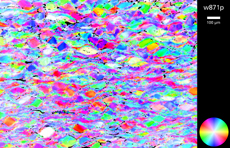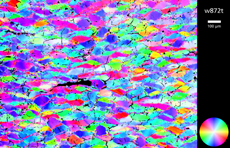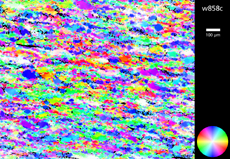4.2
ORIENTATION IMAGES OF EXPERIMENTALLY DEFORMED ROCKS
top / contents / section 4 / pages -- 4.1 -- 4.2 -- 4.3 -- 4.4 -- 4.5 -- 4.6 -- 4.7
Regime 1, 2 and 3 of dynamic recrystallization

Quartz aggregates (Black Hills quartite), experimentally deformed by dislocation creep, exhibit three distinct microstructural and mechanical regimes, dependent on temperature and strain rate, characterized by different mechanisms of dynamic recrystallization: regime 1 at low T is characterized by little or no dislocation climb and recrystallization involves grain boundary migration; regime 2 at intermediate T involves easy dislocation climb and recrystallization by progressive subgrain rotation; and regime 3 at high T is also characterized by easy climb but recrystallization occurs mostly by grain boundary migration (Tullis & Heilbronner, 1999).
Experimental conditions:
regime 1:
- pc = 1.5 GPa
- T = 850°C
- strain rate = 10-5 s-1
- as-is
regime 2:
- pc = 1.5 GPa
- T = 900°C
- strain rate = 10-5 s-1
- 0.17 wt% water added
regime 3:
- pc = 1.5 GPa
- T = 900°C
- strain rate = 10-6 s-1
- 0.17 wt% water added
Left, from top to bottom:
- Regime 1 (w875)
- Regime 2 (w874)
- Regime 3 (w860)

